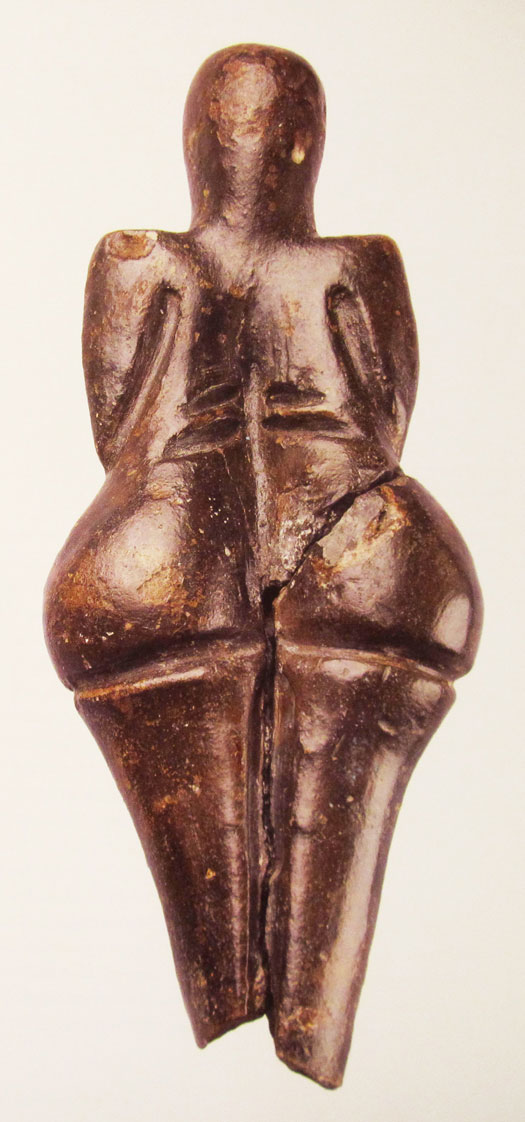Ice Age Art
She towers above me, monumental and minute. She is breathtakingly beautiful, naked, full-figured, post-natal. She is in a very real sense our mother, artistically and genetically. She is thirty thousand years old, yet utterly modern.
Her body is, frankly, fat. Her breasts are full and pendulous, with the look of a woman who has fed and is still feeding children. Her buttocks are large, her hips broad, but her waistline is narrow at the level of her ribs. Her arms merge with her body, her feet have been broken off, her face reduced to a few marks, which could indicate hair pulled back, or her eyes. Her vulva is not indicated, there is no genital cleft, no male-viewed fork. My immediate feeling is that she is a self-portrait, depicting what a creator-woman knows of herself and her body, what she can see of herself, and her mates, what she can feel. Her features are dramatic, but not grotesque.

She is known as the “Woman from Dolní Vĕstonice”, now in the Czech Republic. She is less than five inches tall. She is also the earliest known fired ceramic piece of any sort in the world. The earliest vessel pottery fragments, from the Xianrendong Cave in south central China are just over half her age. Blackened by time, and slightly glossy from restoration, she was made from reddish clay, and either fired in the site’s central firepit, as were many small sculptures of animals; lions, rhinoceroses and mammoths, or in what may be the earliest known kiln.
It is difficult to grasp her distance from us in time. Brian Boru ruled in Ireland one thousand years ago, and Julius Caesar was as remote from him as he from us. One thousand years before Caesar lived, Stonehenge was already one thousand years old and Egypt’s earliest pyramids one thousand years older again. But that has only taken us back five thousand years, a quarter of the “Woman of Dolní Vĕstonice’s” ceramic lifespan.
The wonder of this “Ice Age Art” is its modernity, hence the subtitle of the British Museum’s Exhibition, “the arrival of the modern mind.” The cave paintings of Lascaux, Altamira and Chauvet prove that our remote ancestors were superb artists, the equal in vision and expression of any who have come since. Indeed, many a “modern” artist has used, and still uses their work as a source of images. Many of the bone and ivory carvings in the exhibition were of simply breath-taking beauty, subtlety, and sophistication. The “modernity” of the artworks lies in their combination of lively naturalism and subtle abstraction. Some pieces, such as the lion-headed man, from Hohlenstein in Germany, are reckoned to have taken four hundred hours to carve from mammoth tusk using flint blades and scrapers. This suggests that the maker must have been a valued member of their hunter-gatherer community. Someone had to support and feed those four hundred hours, at a time when the ice was still a dominant feature, and food hard to come by.
Archaeologists are the first to admit that we don’t know why these figures were made. They are often described as being shamanic, ritualistic, or magical. In Dolní Vĕstonice, many of the human figurines were deliberately broken, after untold hours of painstaking carving in stone. It seems clay images were placed in the fire wet, so that they exploded. A potter’s nightmare nowadays, but maybe magical then. Maybe, like many of the discarded Inuit stone carvings so enthusiastically collected by late Victorian explorers, they were thrown away to eliminate diseases. Then again, some of the earliest cave paintings are simply handprints, created by spraying a mouthful of ochre over the hand pressed against the wall. The size of the prints indicates that children and adults of both sexes left their mark.
Although the settlement at Dolní Vĕstonice was pre-agricultural, it seems to have been stable over a considerable period. The people lived in huts within a fenced perimeter around a central fire-pit. They were hunters of deer and mammoths, at risk from bears and lions. To be fat in such a society must have been a privilege, the mark of high status, even of veneration. In a world that was harsh and fraught with danger, the artifacts reflect an intense and imaginative vision of life, a very modern feeling for the power and beauty of living things. Other objects show a love of abstract decoration and pattern making, jewelry and ornament.

But it is the “Woman of Dolní Vĕstonice” who haunts me, who stays with me. She lived in central Europe at a time when the entire population of Europe was only a few thousand. Genetically we are all her direct descendants. As clay shapers and ceramic artists, she is our great mother.
This piece is a reflection on the exhibition ‘Ice Age Art – the arrival of the modern mind’, shown at the British Museum, London, 2013. It was first published in Ceramics Ireland, Spring 2013.
